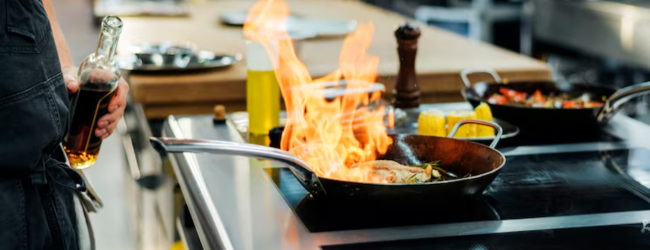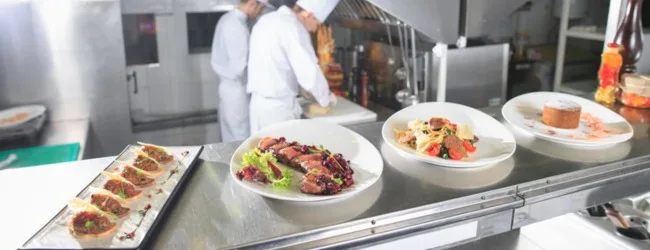Table of contents
- Why Choose the Cloud Kitchen Business Model?
- 5 Effective Steps to Build Your Cloud Kitchen Business
- Step 1: Research, Concept, and Niche Selection
- Step 2: Solid Business Plan and Legal Groundwork
- Step 3: Strategic Location and Efficient Kitchen Setup
- Step 4: Mastering Technology and Operations
- Step 5: Smart Marketing and Customer Acquisition
- Key Factors for Success in the Cloud Kitchen Space
- Conclusion
- Frequently Asked Questions (FAQs)
The way we eat is changing rapidly. Online food delivery isn’t just a convenience anymore; it’s a major part of the food industry, especially in India. This shift has paved the way for an exciting and efficient concept: the cloud kitchen business model.
But what exactly is a cloud kitchen? Imagine a restaurant stripped down to its core function: cooking delicious food. Cloud kitchens, also known as ghost kitchens or delivery-only kitchens, are commercial cooking facilities designed exclusively for preparing food for delivery or takeaway. There’s no dine-in space, no fancy storefront, and no front-of-house staff. This lean approach focuses entirely on fulfilling online orders efficiently.
The Indian cloud kitchen market is booming. Valued at around USD 1.3 billion in FY2024, it’s projected to soar to USD 4.4 billion by FY2032, growing at a remarkable CAGR of over 16%. If you’re an aspiring foodpreneur, understanding the cloud kitchen business model is key to tapping into this lucrative market. This article provides a step-by-step guide with 5 effective steps to build your own successful cloud kitchen business in India.
Why Choose the Cloud Kitchen Business Model?
Before diving into the steps, let’s look at why this model is gaining such immense popularity:
- Lower Startup Costs: Compared to a traditional restaurant needing a prime location, décor, and dine-in staff, cloud kitchens require significantly less initial investment. Setup costs in India can range roughly from ₹5 lakhs to ₹20 lakhs, depending heavily on scale, equipment, and location, which is often much lower than the ₹50 lakhs to ₹1 Crore+ needed for a full-service restaurant.
- Reduced Operational Overheads: No need for front-of-house staff, expensive high-street rent, or elaborate interiors means lower monthly running costs.
- Flexibility and Scalability: You can start small and expand easily. The model allows you to test different concepts or even run multiple brands from a single kitchen (like Rebel Foods does with Faasos, Behrouz Biryani, and Oven Story), maximising kitchen utilisation.
- Wider Customer Reach: By partnering with food delivery aggregators like Zomato and Swiggy, you gain instant access to a vast online customer base without needing a physical presence in multiple locations.
- Adaptability: Cloud kitchens can quickly adapt menus and concepts based on customer data and changing trends, a crucial advantage in the fast-paced food industry.
5 Effective Steps to Build Your Cloud Kitchen Business
Ready to launch? Follow these five key steps:

Step 1: Research, Concept, and Niche Selection
Don’t start cooking without a plan! Thorough research is the foundation of any successful business.
- Identify Your Target Audience & Location: Who are you cooking for? Office workers, families, students, health-conscious individuals? Where do they live or work? Choose a location with good demand density for your target cuisine and reasonable rent, ensuring it’s accessible for delivery partners. It doesn’t need to be a high-footfall area.
- Analyze the Competition: What other cloud kitchens or delivery-focused restaurants operate in your chosen delivery radius? What cuisines do they offer? What are their price points and customer reviews? Find gaps in the market.
- Choose Your Niche & Cuisine: Specialise! Instead of offering everything, focus on a specific cuisine or concept (e.g., Authentic Biryani, Gourmet Burgers, Healthy Salads, Regional Thalis, Vegan Desserts). Highlight: A strong niche helps you stand out.
- Develop Your Brand & Menu: Create a catchy brand name, logo, and brand story. Design a concise, delivery-friendly menu. Focus on dishes that:
- Travel well and maintain quality.
- Have a food cost ideally under 30-35%.
- Can be prepared efficiently.
- Offer good profit margins (often priced at 3.5-4x the food cost).
Step 2: Solid Business Plan and Legal Groundwork
Treat your cloud kitchen like any serious business venture.
- Create a Detailed Business Plan: Outline your concept, target market, menu, pricing strategy, marketing plan, operational plan, team structure, and financial projections (startup costs, operational expenses, revenue forecasts, break-even point).
- Secure Funding: Determine how you’ll finance your venture – personal savings, bank loans, or investors. Your business plan is crucial for securing external funding.
- Legal Structure: Decide on your business structure (Sole Proprietorship, Partnership, LLP, Private Limited Company).
- Essential Licenses (India): This is non-negotiable. You’ll primarily need:
- FSSAI License: Mandatory for all food businesses. The type (Basic, State, Central) depends on your annual turnover (Basic: <₹12 Lakhs, State: ₹12 Lakhs – ₹20 Crores, Central: >₹20 Crores or multi-state operations).
- GST Registration: Required if your turnover exceeds the threshold (generally ₹20 lakhs, but check current state-specific limits).
- Shop and Establishment Act License: Required by the local municipal authority.
- Trade License: Also issued by the local municipality.
- Fire Department NOC (No Objection Certificate): Ensures fire safety compliance.
- (Optional but recommended) Health license, Signage license, etc., depending on local regulations. Highlight: Ensure all legal compliances are met before starting operations to avoid penalties. [Link to your detailed blog post about FSSAI licenses, if available]
Step 3: Strategic Location and Efficient Kitchen Setup
While you don’t need a prime retail spot, the location and kitchen layout are critical for the cloud kitchen business model.
- Location: Prioritise areas with high order density for your target cuisine, good road connectivity for delivery riders, and affordable rent. Check zoning regulations.
- Kitchen Space: Look for spaces around 300-600 sq. ft. (depending on scale and number of brands). Ensure proper ventilation, water supply, drainage, and power load capacity.
- Layout Design: Highlight: Optimize for workflow efficiency! Design distinct areas for receiving, storage (dry, cold, frozen), preparation, cooking, packing, and dispatch to ensure a smooth flow and minimise delays. An assembly-line approach works well.
- Essential Equipment: Invest in commercial-grade equipment suitable for your menu:
- Cooking range, ovens, grills, fryers.
- Refrigerators and freezers.
- Work tables (stainless steel recommended).
- Exhaust system (chimney/hood).
- Sinks (3-compartment sink often required).
- Storage racks and containers.
- POS system hardware, KOT printers.
- Packaging supplies station.
- Fire safety equipment.
Step 4: Mastering Technology and Operations

Technology is the backbone of the cloud kitchen business model.
Order Management:
- POS System: Invest in a Point-of-Sale system designed for cloud kitchens/delivery businesses. It should integrate with online ordering platforms.
- Aggregator Platforms: List your brand on major platforms like Zomato and Swiggy. Optimize your profile with clear descriptions, high-quality photos, and accurate menu details. Be aware of commission rates (often 15-30%), which impact profitability.
Kitchen Operations:
- Kitchen Order Ticket (KOT) System: Use digital or printed KOTs to manage order flow efficiently in the kitchen.
- Inventory Management: Use software or robust spreadsheets to track stock levels, manage procurement, and minimise waste.
Delivery Logistics:
- Aggregator Delivery: Leverage the delivery fleets of Zomato, Swiggy, etc.
- Own Delivery Fleet: Consider building your own fleet (or using third-party logistics like Dunzo/Shadowfax) for better control and potentially lower costs on direct orders, especially as you scale.
- Packaging: Highlight: Don’t underestimate packaging! Use high-quality, leak-proof, food-grade containers that maintain food temperature and presentation. Consider eco-friendly options. Branded packaging enhances recall.
- Hygiene & Safety: Implement strict Standard Operating Procedures (SOPs) for food safety and hygiene, complying with FSSAI guidelines. Regular staff training is essential.
Step 5: Smart Marketing and Customer Acquisition
Since you don’t have a physical storefront, online marketing is crucial.
Online Presence:
- Website/Landing Page: Create a simple, mobile-friendly website with your menu, online ordering capability (optional, for direct orders), and contact information.
- Social Media: Build a strong presence on platforms like Instagram and Facebook. Post high-quality food photos, run contests, share behind-the-scenes content, and engage with followers.
Aggregator Optimization: Treat your listing on Zomato/Swiggy like your digital storefront. Use relevant keywords, excellent photos, run platform-specific ads and promotions. Encourage positive reviews.
Digital Advertising: Use targeted ads on social media and Google to reach potential customers in your delivery zones.
High-Quality Food Photography: Highlight: Invest in professional photos! Customers eat with their eyes first, especially online. Appetising visuals are critical for attracting orders.
Promotions & Discounts: Offer introductory discounts, combos, and loyalty programs to attract new customers and retain existing ones.
Customer Relationship Management (CRM): Collect customer feedback through reviews and direct communication. Respond to feedback promptly and use insights to improve. Build an email or WhatsApp list for direct marketing (with consent). [Link to your guide on restaurant marketing, if available]
Key Factors for Success in the Cloud Kitchen Space

Building a cloud kitchen is just the start. Long-term success depends on:
- Food Quality & Consistency: Delivering delicious food consistently is paramount.
- Operational Efficiency: Streamlined processes from order taking to delivery ensure speed and cost control.
- Smart Menu Engineering: Regularly analyse dish profitability and popularity. Adapt your menu based on data.
- Effective Cost Management: Keep a close eye on food costs, labour, rent, utilities, and marketing spend.
- Strong Branding & Marketing: Stand out in a crowded online marketplace.
- Adaptability: Be ready to innovate and adapt to changing customer preferences and market trends.
- Managing Aggregator Reliance: While necessary initially, explore direct ordering channels to improve margins over time.
Conclusion
The cloud kitchen business model offers a dynamic and potentially profitable route into India’s thriving food industry. By minimising traditional restaurant overheads and leveraging technology, it provides a scalable and adaptable framework for food entrepreneurs. However, success isn’t guaranteed. It requires meticulous planning, operational excellence, consistent quality, smart marketing, and a deep understanding of the target market.
By following these 5 effective steps – from thorough research and planning to mastering operations and marketing – you can lay a strong foundation for building your own successful cloud kitchen business and grabbing a slice of the burgeoning food delivery market.
Frequently Asked Questions (FAQs)
1. What exactly is a cloud kitchen?
A cloud kitchen (or ghost kitchen/delivery-only kitchen) is a commercial facility built exclusively for preparing food for delivery or takeaway. It has no physical dine-in space for customers. Its business relies entirely on online orders, often placed through food aggregator apps or its own website/app.
2. How much does it cost to start a cloud kitchen in India?
The initial investment typically ranges from ₹5 lakhs to ₹20 lakhs or more. Key costs include kitchen equipment, rental deposit and advance, licenses, initial inventory, technology (POS), and initial marketing. It’s significantly less than setting up a traditional restaurant.
3. What licenses are essential for a cloud kitchen in India?
The main licenses required are:
- FSSAI License (Food Safety and Standards Authority of India)
- GST Registration
- Shop and Establishment Act License
- Trade License
- Fire Department NOC
4. Is a cloud kitchen business profitable in India?
Yes, it can be highly profitable due to lower overheads compared to traditional restaurants. Profit margins can range from 10% to 25% or more, but depend heavily on factors like order volume, average order value, food cost control, operational efficiency, rent, and aggregator commission fees. Initial months might see lower profits or losses during the brand-building phase.
5. What are the main challenges of running a cloud kitchen?
Key challenges include:
- High commission fees charged by delivery aggregators (15-30%).
- Intense competition in the online space.
- Maintaining consistent food quality and hygiene for delivery.
- Building brand visibility and customer loyalty without a physical presence.
- Managing delivery logistics and ensuring timely delivery.
- High marketing costs to stand out online.
6. Cloud Kitchen vs. Traditional Restaurant: What’s the main difference?
The core difference is the presence of a dine-in space. Traditional restaurants serve customers on-premises, incurring costs for seating, ambiance, and front-of-house staff. Cloud kitchens focus solely on delivery/takeaway, eliminating these costs but relying heavily on online visibility and efficient delivery operations.
7. How do cloud kitchens market themselves without a physical storefront?
They rely heavily on digital marketing:
- Listing and optimizing profiles on food delivery apps (Zomato, Swiggy).
- Social media marketing (Instagram, Facebook).
- Search engine marketing (Google Ads).
- High-quality food photography.
- Online promotions and discounts.
- Building their own website/app for direct orders.
- Customer relationship management (CRM) and loyalty programs.
8. Can I run multiple brands from one cloud kitchen?
Absolutely! This is a key advantage of the cloud kitchen business model. Companies like Rebel Foods operate multiple brands (e.g., Faasos, Behrouz Biryani, Oven Story) focusing on different cuisines from the same shared kitchen infrastructure. This maximizes efficiency and caters to diverse customer preferences.


